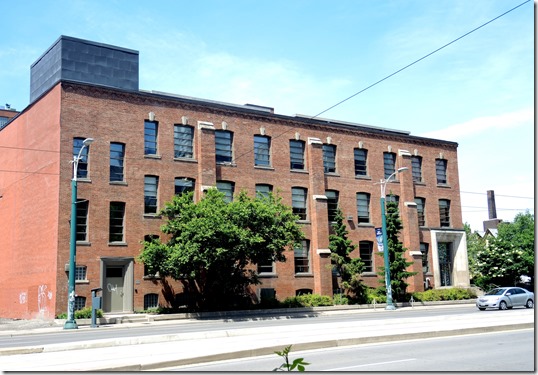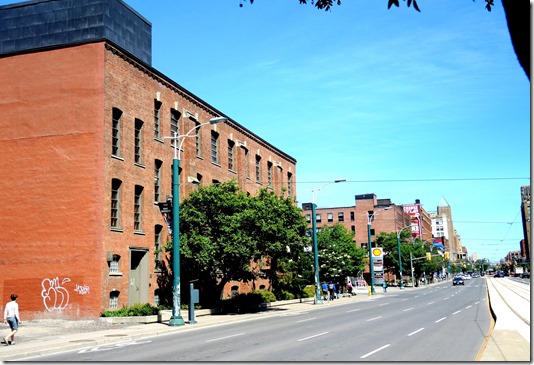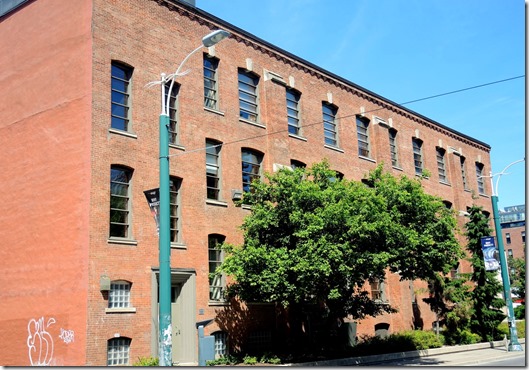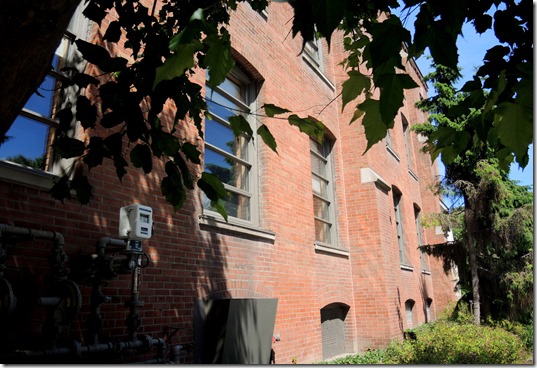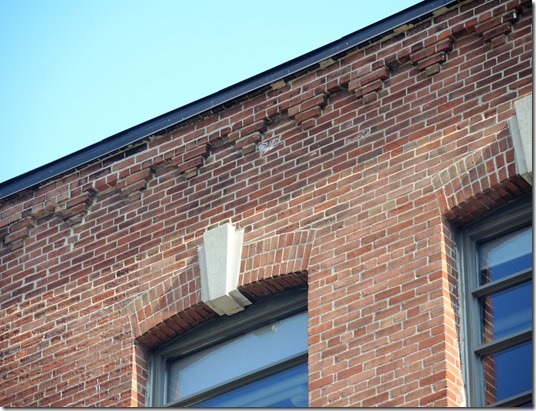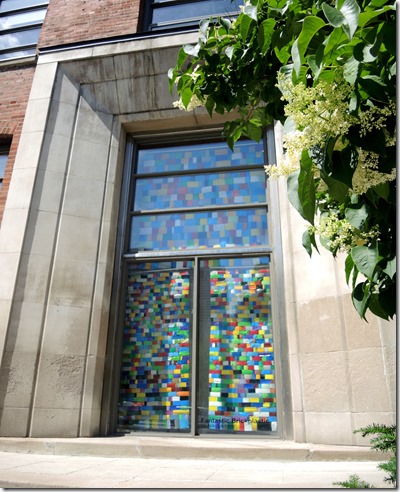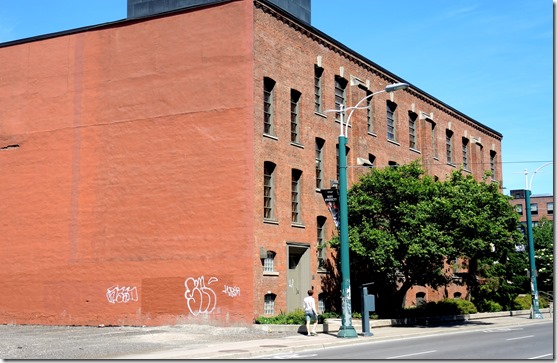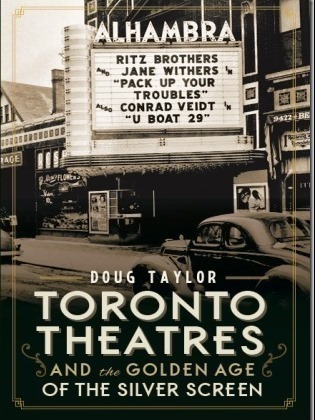View of the east facade of the Gale Building at 24-30 Spadina Avenue.
Researching the history of the Gale Building at 24-30 Spadina Avenue was not easy. I was unable to find any postal address on the building, but since it was located near the southwest corner of Wellington and Spadina, I ascertained the address through the Toronto Directories and rechecked it on a map in the Goad’s Atlas.
The Gale Building was constructed at the height of Toronto’s railway era, shortly after the beginning of the 20th century. However, the railroads had first appeared in Toronto in the 1850s and during the decades ahead, the number of rail lines increased until they occupied much of the land hugging the lakeshore and the land to the north of the lake. This caused the area of Spadina, north of the rail lands, to be viewed as less desirable for residential purposes. On streets such as Wellington Street West, the grand homes and estates began to disappear, including those of J. Denny, H.L. Seaton and Ja’s Michie. On the east side of Spadina, the avenues surrounding Clarence Square also had grand homes, but these too disappeared in the latter decades of the 19th century and the first decade of the 20th.
Wealthy families vacated the lower portion of Spadina Avenue and moved further north to areas such as Rosedale. Their mansions and grand homes were demolished, the land they had occupied employed by companies for factories and warehouses.
According to the Toronto Directories, in 1905 houses existed where 24-34 Spadina is located today. The following year, they were demolished and in 1907, a factory/warehouse appeared on the site. It was one of the earliest manufacturing and distribution buildings in the area—the Gale Building. Its location capitalized on its proximity to the lake and the rail lands, both immediately to the south.
The three-storey red-brick structure possesses a basement that is partially above ground, adding another full storey of useable space. Its facade facing Spadina is unadorned, although there are a few simple embellishments near the cornice. The stone trim around the north doorway of the east facade is one of the few impressive features of the building. The company manufactured “whitewear,” specializing in fine earthenware—plates, platters, bowls and porcelain crockery—all of which were white.
During the decades ahead, the building continued to be named the Gale Building, but much of the interior space was rented to other occupants. In 1929, the only company listed in the building was Eisman Company Limited, manufacturers of corsets and and rubber specialties. In 1948, though still named the Gale Building, it was occupied by J. H. McNairn Paper Manufacturer, and on the second floor was the Dominion Paper Box Company.
When I moved into the area in November 2000, the McGregor Sock Company maintained a retail outlet in the building, its postal address listed as 30 Spadina Avenue. I googled the address recently (October 2014), but was unable to discover the present-day occupants. It is assumed that it has various tenants.
The Gale Building, 24-30 Spadina Avenue. View gazes north on Spadina from near Front Street. Photo taken in 2014
The east facade of the Gale Building in 2014.
The north facade of the Gale Building, facing Wellington Street West.
The brickwork below the cornice on the east facade and the stone trim above the windows on the third floor.
The north doorway on the east facade.
The east and south facades of the Gale Building.
To view the Home Page for this blog: https://tayloronhistory.com/
To view links to other posts placed on this blog about the history of Toronto and its buildings:
https://tayloronhistory.com/2013/10/08/links-to-historic-architecture-of-torontotayloronhistory-com/
To view previous blogs about old movie houses of Toronto—historic and modern
https://tayloronhistory.com/2013/10/09/links-to-toronto-old-movie-housestayloronhistory-com/
Recent publication entitled “Toronto’s Theatres and the Golden Age of the Silver Screen,” by the author of this blog. The publication explores 50 of Toronto’s old theatres and contains over 80 archival photographs of the facades, marquees and interiors of the theatres. It also relates anecdotes and stories from those who experienced these grand old movie houses.
To place an order for this book:
Theatres Included in the Book:
Chapter One – The Early Years—Nickelodeons and the First Theatres in Toronto
Theatorium (Red Mill) Theatre—Toronto’s First Movie Experience and First Permanent Movie Theatre, Auditorium (Avenue, PIckford), Colonial Theatre (the Bay), thePhotodome, Revue Theatre, Picture Palace (Royal George), Big Nickel (National, Rio), Madison Theatre (Midtown, Capri, Eden, Bloor Cinema, Bloor Street Hot Docs), Theatre Without a Name (Pastime, Prince Edward, Fox)
Chapter Two – The Great Movie Palaces – The End of the Nickelodeons
Loew’s Yonge Street (Elgin/Winter Garden), Shea’s Hippodrome, The Allen (Tivoli), Pantages (Imperial, Imperial Six, Ed Mirvish), Loew’s Uptown
Chapter Three – Smaller Theatres in the pre-1920s and 1920s
Oakwood, Broadway, Carlton on Parliament Street, Victory on Yonge Street (Embassy, Astor, Showcase, Federal, New Yorker, Panasonic), Allan’s Danforth (Century, Titania, Music Hall), Parkdale, Alhambra (Baronet, Eve), St. Clair, Standard (Strand, Victory, Golden Harvest), Palace, Bedford (Park), Hudson (Mount Pleasant), Belsize (Crest, Regent), Runnymede
Chapter Four – Theatres During the 1930s, the Great Depression
Grant ,Hollywood, Oriole (Cinema, International Cinema), Eglinton, Casino, Radio City, Paramount, Scarboro, Paradise (Eve’s Paradise), State (Bloordale), Colony, Bellevue (Lux, Elektra, Lido), Kingsway, Pylon (Royal, Golden Princess), Metro
Chapter Five – Theatres in the 1940s – The Second World War and the Post-War Years
University, Odeon Fairlawn, Vaughan, Odeon Danforth, Glendale, Odeon Hyland, Nortown, Willow, Downtown, Odeon Carlton, Donlands, Biltmore, Odeon Humber, Town Cinema
Chapter Six – The 1950s Theatres
Savoy (Coronet), Westwood
Chapter Seven – Cineplex and Multi-screen Complexes
Cineplex Eaton Centre, Cineplex Odeon Varsity, Scotiabank Cineplex, Dundas Square Cineplex, The Bell Lightbox (TIFF)
